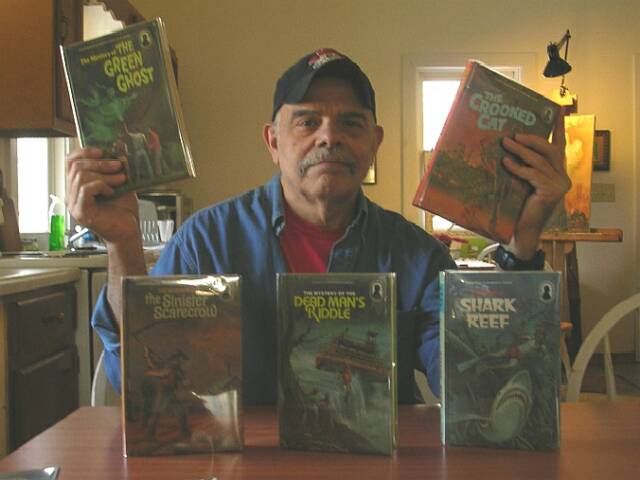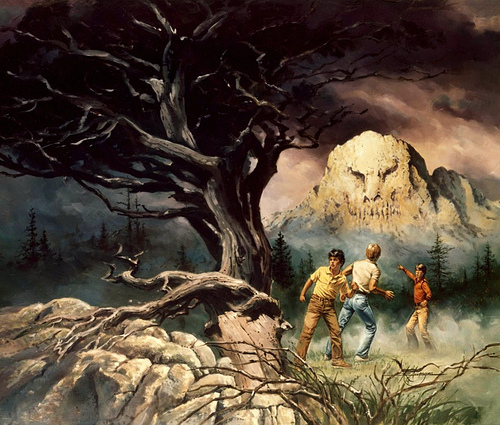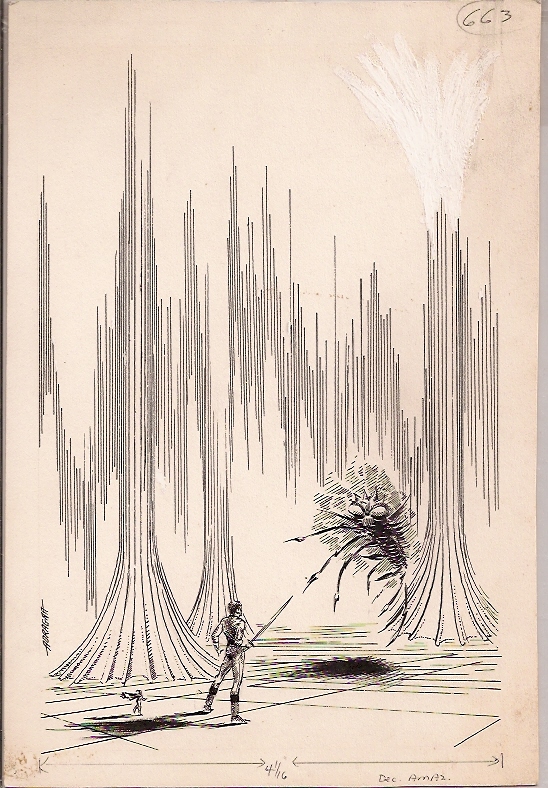Three Investigators Artist
Robert J. Adragna
Bob Adragna in his home on December 12, 2009.
Photo courtesy of Robert Adragna & Dan Napolitano.
In 1979 Random House hired Robert Adragna to create cover art for new titles being written in The Three Investigators series (titles #29 - #43). From 1979 through 1985, Mr. Adragna also created new cover art for the first 28 titles. The Adragna cover art can be found on the following editions:
The Hitchcock Paperback trade edition. Consists of titles #1 - #6 & #9 - #30. Titles #7 and #8 were never published
in this format.
The Keyhole Paperback trade edition. Consists of all 43 titles in the original series.
The Weekly Reader hardback edition. Consists of titles #3 and #12 only.
The Gibraltar Library Binding (GLB) hardback edition. In this edition titles #29 - #43 were only published with the
Adragna covers. In addition, later printings of the following eight
titles can also be found: #'s 4, 5, 13, 17, 20, 21, 22 and 23.
These latter are referred to as "The Elusive Adragna Eight" as
they are difficult to find and thus highly prized by collectors.
For many years Robert Adragna proved to be something of a mystery to fans of The Three Investigators. His last known cover paintings appeared on books published in the mid-1990's and on-line research revealed amazingly little biographical information about this talented artist. Late in 2009, Three Investigators fans managed to track him down.
The following article was written and contributed by a Three Investigators enthusiast who had an opportunity to meet with Robert Adragna in December, 2009:
Original cover painting for Monster Mountain, 1979.
Image courtesy of Robert Adragna.
Rediscovering Adragna: a Look at the Original Series' Final Original Artist
by Dan Napolitano
Certainly, Robert Adragna's artistic contributions to The Three Investigators series hold a place of highest interest and regard among T3I series enthusiasts. Perhaps one reason is that, without attempting to do anything other with the Investigators' traditional look than bring them into the eighties (as Ed Vebell had brought the boys into the seventies, by updating their clothing and hair styles), Adragna transformed the series' visual identity dramatically, giving the fifteen year-old franchise contemporary and fresh appeal. This top science fiction and fantasy stylist took the tints, tones, sharp lines, and otherworldly saturation of his prior work and used them to re-imagine the Investigators' world for an adolescent audience that had experienced Star Wars only two years earlier—a readership entering its teenage years as the first Summer blockbuster generation.
In a way, Adragna accomplished visually what Random House could not through narrative. With the Crimebusters series, the publisher struggled to connect the trio of teen detectives to its second generation of readers by putting away "childish" ghost stories, lost treasures, and the innocent beach towns of every boy's summer vacations. Instead, Random House provided the now-older Investigators with driver's licenses, distractions from girls and music, contemporary slang (language more sharply dated today than that of the original series), and no-larger-than-life criminals committing no-larger-than-life crimes against the background of a more realistic Los Angeles. Most T3I readers feel that, in Crimebusters, something magical was lost when childhood passed; the second series' life was short. Adragna, on the other hand, connected more viscerally with the Investigators' target audience simply by seeing the classic series' adventures through a cinematic eye, one better suited to tantalize a generation growing up from readers into watchers.
Less broadly and a little more daringly, one might also suggest that the appeal of an Adragna T3I cover is simply this: all the other T3I artists combined did not produce as many covers transporting young readers into that zone of immediate and imaginative excitement that an Adragna cover routinely does. Only Harry Kane's last three covers (Coughing Dragon, Flaming Footprints, and Nervous Lion), and Ed Vebell's Phantom Lake (perhaps, too, his Singing Serpent), seem to generate the same eager anticipation in young readers to dig into the young detectives' latest adventure. While Kane was the original, irreplaceable illustrator who indelibly defined the characters' appearance, and while Ed Vebell was the most gifted T3I draftsman, Adragna was clearly the best T3I painter.
Adragna is a native New Yorker, born in Brooklyn. During most of his career, Bob lived in the city, for most of that time (twenty-seven years) in the same, small midtown Manhattan apartment that had, as Bob describes it, "the smallest bathroom you could possibly believe." The entire apartment was perhaps 300 square feet. (Happily, now in retirement, Bob enjoys considerably more space and comfort.)
As a boy, Adragna attended parochial school. Although Bob always knew he wanted to be an artist, he doubted his potential to become one. The nuns encouraged him to pursue an art career, though sometimes in ways he found unnerving, such as making Bob go from class to class to show his artwork. The nuns also encouraged Adragna to apply to a commercial arts high school in Manhattan, Industrial Art (which later became the High School of Art and Design). Bob applied, was accepted, and graduated. His first paid position after graduation was as an artist with Norcross Greeting Card Company.
Even before Bob graduated from art school, however, he shopped his portfolio to several pulp magazines. Bob's big break came from none other than John W. Campbell, the editor of Astounding Science Fiction, and the person generally credited with initiating the Golden Age of Science Fiction. Isaac Asimov characterized Campbell as, "the most powerful force in science fiction ever…for the first ten years of his editorship he dominated the field completely." This is the intimidating figure to whom the brash young Adragna successfully marketed his talent. (T3I readers may be tempted to compare this encounter to Jupiter Jones' first with the master himself, Alfred Hitchcock, but unlike the "insufferable" Jones, Adragna strikes new acquaintances as being very personable and easygoing.) Adragna's work for Campbell led to conspicuous recognition in the science fiction, horror, and fantasy genres, including further cover work for Amazing Stories, Fantastic, and Heavy Metal, as well as any number of book covers.
The accomplished Adragna had less need to shop himself brazenly into Random House. In 1979, Bob submitted his portfolio to Random House (mostly Western art at that time), because he was attracted to Random House's practice of paying artists half their fees in advance (which was not then common). The publisher asked Adragna to interview with an art director who was, by coincidence, a former high school classmate named Bruce Hall. Bob produced several covers for Hall's projects, including some Westerns and a romantic mystery novel. Then, at Hall's invitation, Bob began working with a new, young art director named Cathy Goldsmith, whose current project was…The Three Investigators. Goldsmith had seen Adragna's work for Hall and requested him. (Goldsmith would go on to work with other highly recognized artists, including Dr. Seuss; she still works at Random House with a focus on young readers. Among her more recent work is the Babymouse graphic novel series for girls.)
Random House also paid its artists' expenses for the hiring of models and
photographers, another perk Bob appreciated. Adragna had a regular professional relationship with photographer Bob Osonitsch, who recruited and photographed the various models posing as the Three Investigators for Bob's T3I cover paintings. Occasionally, Adragna—an accomplished photographer himself—would save Random House model and photography fees by standing in as both photographer and subject. For instance, T3I fans will be particularly interested to learn that it is Adragna, stuffed animal in hand, gamely outstripping the investigators on Bob's cover for The Secret of the Crooked Cat.
Goldsmith provided Bob synopses of the two Three Investigators books in production at that time—Sinister Scarecrow and Shark Reef—and offered Bob the opportunity to win the assignment for these covers. Bob's initial paintings were a great success, so Random House eventually engaged Bob to produce new covers for all forty-three titles—one at a time, not as group. The assignment, segmented though it was, exceeded Adragna's initial hopes. At first, he only hoped and expected to have the opportunity to paint several covers.
Adragna's regular approach for selecting a cover scene was to read the book's synopsis and, sometimes for inspiration, to skim the book's manuscript. (Both the synopsis and manuscript were provided to him by his art director.) Essentially, though, he confesses that, often, "I…took the title, and just embellished…on the title…I always felt that, whatever the title of the book was, that that should be an integral part of the cover." Bob cites Silver Spider and Flaming Footprints among his favorites to paint.
Almost all Bob's T3I cover paintings were oil compositions on artist's board. One notable exception is Skull Mountain (the cover painting for Monster Mountain), which was painted on Masonite as a full, wrap-around scene. (See the image below; Random House only printed the right half of the scene on the front cover of Monster Mountain, so the full scene can only be enjoyed through the photograph of the original painting.) Earlier in his career, Adragna painted routinely on Masonite—but porting a portfolio of Masonite paintings from publisher to publisher quickly became too heavy and impractical, so he began using artist's board, instead.
Another little-known fact among T3I collectors is that Bob first produced a small (actual book-sized), oil-painted concept sketch for each cover, which he showed to his art director for approval before executing the much larger, finished version. Unlike the editors' interactions with Harry Kane about Kane's preliminary sketches (click HERE to see an example), Bob's art director "made very little changes on anything I did. I mean, I almost can't recall any dispute about anything…as long as they were dramatic…she wasn't as picky about the story. Occasionally she might, but nothing major." (Adragna routinely produced sketches for covers he painted, including his science fiction and fantasy covers.) Although it is apparent in Bob's work, Adragna is a self-confessed meticulous painter, and he would spend two weeks or more on each finished painting. (By comparison, Ed Vebell, who had a reputation for speed, took only a day or two to produce each of his original T3I pieces.)
One of Adragna's earliest illustrations.
Original pen/ink illustration published in Amazing Stories, December 1964.
Collection of Seth T. Smolinske.
Adragna's 1981 cover.
Adragna never anticipated any recognition for his work on T3I: "It's kind of amazing. I've had a computer for a long time…I never thought people would be interested in these covers or books. I mean, I just thought they were [for] school kids…and then I started seeing them on web sites in Europe. I started thinking, 'Wow, there are people who are really interested'." Bob expects and hopes that he will be remembered as an artist for his imaginative and beautifully rendered Western and science fiction covers, in which he felt he had opportunity to express himself artistically, without constraint. While he may well be best remembered for that work, it's certain that T3I fans will nonetheless always keep Adragna's work for the series in very high regard.
In addition to painting and photography, Adragna is a lifelong film enthusiast. (He credits film as an influence on his eye and his painting.) He is also a technology hobbyist and sometime computer professional who engineers and builds his own PCs. Bob has added digital art to painting and photography, and currently creates works in all three media.
Interested readers can see hundreds of of Bob's works over time, including his T3I covers, at http://www.flickr.com/photos/bob_dragna/. At the time of this article's publication, Bob is even offering some of his latest original work (no T3I work, sorry!) for sale.
© 2010 Dan Napolitano, all rights reserved.
Back to the Authors/Artists page.
Original 1995 cover painting for Rattler!
Oil on board.
Collection of Seth T. Smolinske.
 | ||||
 | ||||


